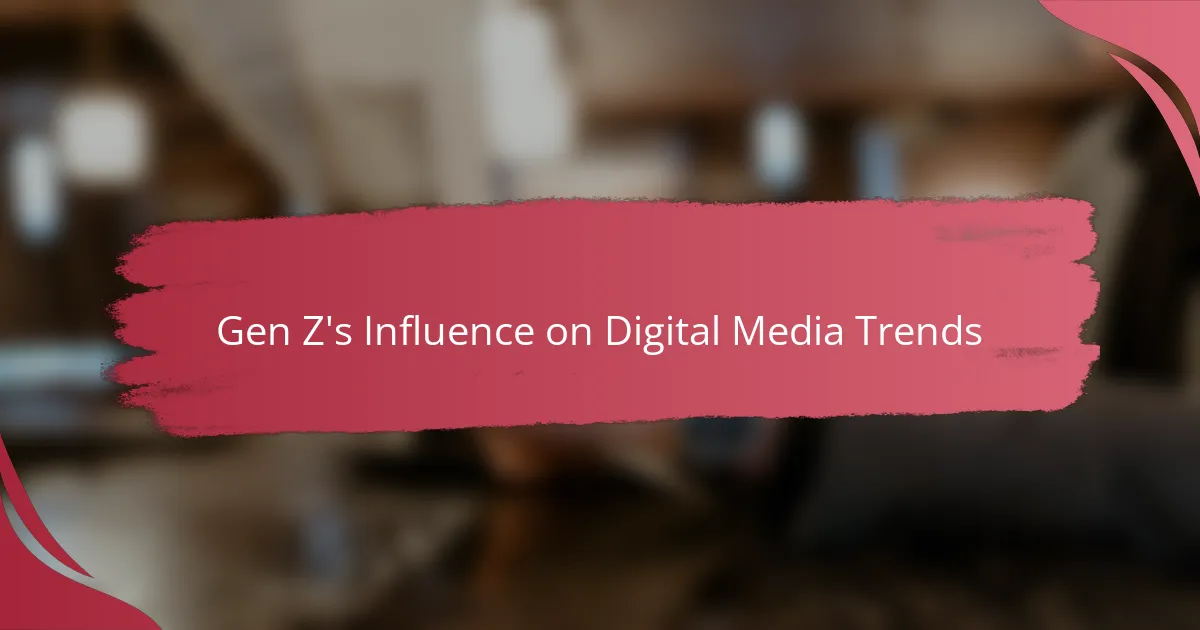The growth of video content in digital media is driven by key trends such as increased mobile consumption, the popularity of short-form videos, and the rise of live streaming. These changes reflect evolving consumer behaviors and technological advancements that enhance engagement and foster deeper emotional connections with audiences. As brands adapt their strategies to leverage these trends, they can significantly boost visibility and impact in an increasingly competitive landscape.

What Are the Key Trends in Video Content Growth?
Key trends in video content growth include increased mobile consumption, the rise of short-form videos, growth in live streaming, integration of interactive elements, and a focus on user-generated content. These trends reflect changing consumer behaviors and technological advancements that shape how video content is created and consumed.
Increased Mobile Consumption
Mobile consumption of video content has surged, driven by the widespread use of smartphones and tablets. Users prefer watching videos on-the-go, leading to a significant shift in content creation strategies that prioritize mobile-friendly formats.
To cater to mobile audiences, ensure videos are optimized for smaller screens, with clear visuals and concise messaging. Consider vertical video formats, as they align better with how users naturally hold their devices.
Rise of Short-Form Videos
Short-form videos, typically lasting under a minute, have gained immense popularity on platforms like TikTok and Instagram Reels. These brief clips cater to users’ dwindling attention spans and encourage quick engagement.
Brands should consider incorporating short-form content into their marketing strategies by creating catchy, impactful videos that convey messages quickly. Aim for a mix of entertainment and information to maximize viewer retention.
Growth of Live Streaming
Live streaming has become a vital component of video content, allowing real-time interaction between creators and audiences. This format fosters a sense of community and urgency, making it appealing for events, product launches, and Q&A sessions.
To effectively utilize live streaming, plan engaging content that encourages viewer participation. Promote upcoming streams in advance and consider using platforms like YouTube Live or Facebook Live to reach wider audiences.
Integration of Interactive Elements
Interactive video content, which includes features like polls, quizzes, and clickable links, enhances viewer engagement by allowing audiences to participate actively. This trend is particularly effective in educational and marketing contexts.
When creating interactive videos, ensure that the elements are seamlessly integrated and enhance the overall experience. Avoid overwhelming viewers with too many options, as this can lead to confusion and disengagement.
Focus on User-Generated Content
User-generated content (UGC) has emerged as a powerful tool for brands, as it builds authenticity and trust. Encouraging customers to create and share their own videos can significantly enhance brand visibility and engagement.
To leverage UGC, create campaigns that invite users to share their experiences with your products. Use dedicated hashtags and feature the best submissions on your platforms to foster community and encourage participation.

How Does Video Content Impact Engagement?
Video content significantly enhances engagement by capturing viewer attention and encouraging interaction. Its dynamic nature allows for deeper emotional connections, which can lead to increased viewer retention and brand loyalty.
Higher Viewer Retention Rates
Video content typically results in higher viewer retention rates compared to text or static images. Engaging visuals and storytelling can keep viewers interested for longer periods, often exceeding several minutes. This increased retention is crucial for brands aiming to convey complex messages or showcase products effectively.
To maximize retention, focus on creating compelling introductions and maintaining a clear narrative throughout the video. Aim for concise content that delivers value quickly, as viewers tend to drop off after a few minutes if their interest wanes.
Improved Brand Recall
Videos enhance brand recall by combining audio and visual elements, making it easier for viewers to remember the brand and its message. Studies suggest that people retain information better when it’s presented in a video format, often recalling brand names and messages at significantly higher rates than with text alone.
To leverage this, brands should incorporate their logos and key messages prominently within the video. Using storytelling techniques that resonate with the target audience can further enhance recall, as emotional connections often lead to stronger memory retention.
Enhanced Social Media Interaction
Video content fosters greater interaction on social media platforms, leading to more likes, shares, and comments. Posts with videos typically receive higher engagement rates, with users more likely to interact with dynamic content than static images or text updates.
To boost social media interaction, brands should create shareable video content that encourages viewers to engage. This can include behind-the-scenes footage, tutorials, or user-generated content. Additionally, incorporating calls to action within the video can prompt viewers to comment or share, further amplifying reach and engagement.

What Are Effective Strategies for Video Marketing?
Effective strategies for video marketing focus on enhancing visibility, engagement, and shareability. By utilizing SEO, leveraging social media, and creating compelling content, brands can significantly increase their reach and impact in the digital landscape.
Utilizing SEO for Video Discovery
SEO for video discovery involves optimizing video content to improve its visibility on search engines and platforms like YouTube. Key practices include using relevant keywords in titles, descriptions, and tags, as well as creating engaging thumbnails that attract clicks.
Consider incorporating closed captions and transcripts to enhance accessibility and improve searchability. Aim for a balance between keyword-rich content and natural language to avoid penalties from search algorithms.
Leveraging Social Media Platforms
Social media platforms are crucial for distributing video content and engaging with audiences. Tailor your video format and messaging to fit the specific platform, whether it’s short clips for TikTok or longer content for Facebook and Instagram.
Utilize features like stories, reels, and live streams to foster real-time interaction. Regularly analyze engagement metrics to refine your approach and determine which types of content resonate best with your audience.
Creating Shareable Content
Creating shareable content requires understanding what drives viewers to share videos. Focus on producing emotionally resonant, informative, or entertaining content that encourages viewers to pass it along to their networks.
Incorporate clear calls-to-action and incentives for sharing, such as contests or giveaways. Keep videos concise and impactful, ideally under two minutes, to maximize the likelihood of shares across various platforms.

How Do Different Formats Affect Video Performance?
Different video formats significantly influence performance metrics such as viewer engagement, retention, and overall reach. Understanding these effects can help creators choose the right format for their audience and objectives.
Comparison of Live vs. Pre-Recorded Videos
Live videos often foster real-time interaction, allowing viewers to engage through comments and questions, which can enhance community building. In contrast, pre-recorded videos offer the advantage of editing, ensuring higher production quality and the ability to convey more complex messages without interruptions.
While live videos can generate excitement and urgency, they may also lead to higher dropout rates if the content does not meet viewer expectations. Pre-recorded videos, however, can be tailored to maintain viewer interest throughout, often resulting in longer watch times.
Impact of Video Length on Viewer Engagement
Video length plays a crucial role in viewer engagement, with shorter videos typically performing better in terms of retention. Content that is concise and to the point, often ranging from 1 to 3 minutes, tends to keep viewers’ attention more effectively than longer formats.
However, longer videos, usually exceeding 10 minutes, can be beneficial for in-depth topics or tutorials, as they allow for comprehensive coverage. Creators should consider their audience’s preferences and the platform’s norms when deciding on video length to maximize engagement.

What Metrics Should Be Used to Measure Video Success?
To effectively measure video success, focus on metrics that reflect viewer behavior and engagement. Key indicators include view count, watch time, engagement rate, and shares, each providing insights into how well your content resonates with the audience.
View Count and Watch Time
View count indicates how many times your video has been watched, while watch time measures the total minutes viewers spend watching it. Both metrics are essential for understanding reach and viewer retention.
For instance, a video with a high view count but low watch time may suggest that viewers are clicking away quickly, indicating a lack of engaging content. Aim for watch times in the range of several minutes for optimal viewer retention.
Engagement Rate and Shares
Engagement rate reflects how actively viewers interact with your video through likes, comments, and shares. A higher engagement rate often correlates with a more invested audience and can enhance visibility on platforms.
Shares are particularly important as they amplify your video’s reach beyond your immediate audience. Encourage sharing by creating compelling content that resonates emotionally or provides value, increasing the likelihood of organic distribution.



